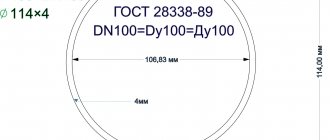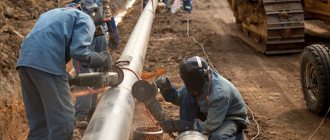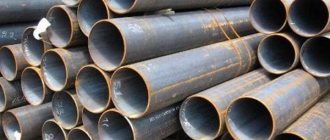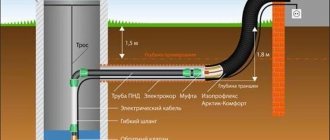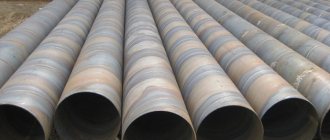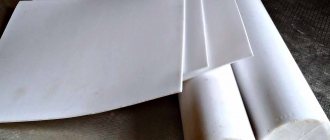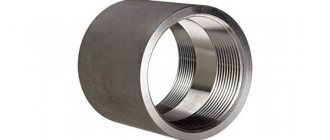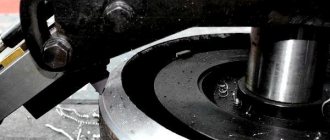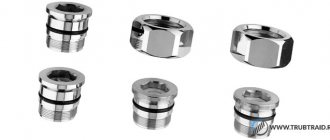What can be used for marking?
For marking the following can be used:
- Indelible paint.
- Electrographs.
- Electric inkjet printing devices.
- Branding.
No data is applied to some types of pipe products, and for those that must have markings, the marking method is selected depending on the grade and main parameters of the pipe.
Description and explanation of the abbreviation VGP
For a long time, VGP pipes have been indispensable elements in the construction of many facilities. They are used for supplying communications:
The abbreviation VGP stands for water and gas pipes . They are considered very durable and are equal to the strength of an all-metal beam of identical diameter.
These products are made from carbon steel . They are always in demand, despite the fact that pipeline materials made of plastic and metal-plastic have now appeared. This is due to the fact that there are areas of communication networks where products made from other materials cannot be used. For example, gas pipelines cannot be laid using plastic products.
VGP products are produced using the technology of welding and forming metal strips. Rolled sheets are used as a workpiece. It is made from carbon hot-rolled structural steel. To ensure that such a material can withstand maximum loads, special attention is paid to the weld seam during the production process. Such finished products must be gas and waterproof. Depending on the wall thickness, products are divided into separate types :
- lungs;
- ordinary;
- reinforced.
They are produced in the form of material in measured and unmeasured lengths. Eight-meter long pipes are considered the most popular. There are also products with a length of 5.8; 7.8; 9 and 11.75 meters. Such parameters are related to the peculiarities of transportation and installation.
Standard marking of steel pipes
All necessary data is applied to the pipes according to a certain standard.
Location of symbols
Manual marking of a steel pipe is printed at a certain distance from the end of the product: no less than 2 cm and no further than 50 cm. With mechanized marking, this value increases and is 0.1 m and 1.5 m.
Symbol size
The letter and numerical designations of the pipe must have a certain size, which is also regulated by a certain regulatory document. Signs must have a height of no less than 0.5 cm and no more than 3 cm, and a width from 0.3 cm to 1.2 cm. The size of the signs is determined in accordance with the parameters of the pipe.
Characteristics
According to the type of product, VGP pipes are divided into two types - black and galvanized steel. The latter type of high-precision products is distinguished by classification according to wall thickness, length, external diameter and nominal bore. They successfully resist corrosion.
Such products are coated with a layer of zinc of at least 30 microns, which increases their service life. The outer diameter of the products ranges from 1.0 to 16.5 cm.
The nominal bore is measured in inches . This allows you to conveniently and easily decide on the selection of additional elements:
Other elements are also selected. The geometric parameters of the pipe are selected according to a special table. It corresponds to the manufactured products in weight and size. In production conditions, such products are manufactured in two modifications:
- without thread;
- with existing threads on both sides, applied by cutting or rolling.
Decoding the numbers in the designations allows you to determine the exact size of the pipe diameter.
There are pipes of ordinary precision. During production, they are not standardized by the following parameters - mechanical characteristics, chemical composition of the material. Such products are successfully used in household communications.
There is also a category of high-precision products. They standardize their chemical composition of the material and mechanical characteristics. This pipeline material is intended for industrial use. It is subject to the highest requirements for strength and reliability.
Division into classes
Conventionally, pipe products are divided into the following classes:
- Class 1 pipes can be used for gaseous and liquid media in irrigation systems. In addition, it is possible to manufacture fencing structures or supports from such products.
- Class 2 pipes can be used in pipelines operating at low and high pressure, transporting oil and petroleum products, gas or water.
- Class 3 pipes are suitable for work at high temperatures.
- Class 4 includes thick-walled drill pipes that can resist strong torsion.
- Class 5 pipes are used in the construction of carriages, cars, overhead cranes, drilling rigs and some furniture structures.
- Class 6 pipes are used in the engineering industry as blanks from which bearings, cylinders, pumps and receivers are produced.
Main advantages
VGP pipes are in demand for the construction of main lines and domestic pipelines. They use gas or water as a working medium. The main advantages of such products are the following indicators:
- low coefficient of linear expansion, which prevents deformation of the structure under the influence of high and very low temperatures;
- high strength compared to polypropylene and many other materials;
- possibility of use in pressure-type structures;
- good thermal conductivity, which has a positive effect on maintaining the temperature of the transported working environment;
- tightness allows the delivery of volatile and gaseous substances, acids and many other chemically active substances through pipes.
A high thermal conductivity coefficient can lead to cooling of the transported working medium. To avoid this, VGP pipes are used with additional thermal insulation materials.
Classification by diameter
It is necessary to understand what diameters of steel pipes there are in order to know what you will have to choose from. Depending on the diameter, special-purpose pipes are also divided into several types:
- Small diameter pipes have a cross-section of no more than 114 mm.
- Medium diameter products - over 114 mm, but not more than 480 mm.
- Large diameter pipes have a cross section greater than 480 mm.
Small diameter pipes
Products of this type are not marked; they are transported in special packaging with an accompanying label. In a similar way, data is applied to pipes obtained in the process of cold deformation with a diameter of no more than 450 mm.
Products must be accompanied by the following information:
- Manufacturer information and order number.
- Date of manufacture and changeover information.
- Package number.
- Batch number.
- Dimensions, including designation of pipe wall thickness.
- Regulatory document.
- Melt number.
- Number of units in one package.
- Theoretical weight (indicated in meters when ordering).
- Actual weight.
- Total footage.
- Recipient code.
Medium diameter pipes
Products whose wall thickness exceeds 3.5 mm and whose diameter exceeds 159 mm are individually marked. Cold-formed pipes with a diameter of more than 159 mm and less than 450 mm are designated on three units of the entire package, and are also accompanied by a special label.
Large diameter pipes
Products with a diameter exceeding 530 mm may have markings inside the pipe.
If the wall thickness is more than 10 mm, then markings can be applied to the end of the products. Depending on the grade of steel used in the production of pipes, the color of the marking is selected. Most often, the pipe symbol is brightly colored to make it easier to find.
Pipes for boiler rooms, in accordance with the steel grade, are designated in the following colors:
- Green markings are applied to grade 20 steel.
- Blue markings are for steel grade 20PV.
- Brown letters and numbers correspond to 15GS steel.
- Yellow markings can be seen on steel grade 15ХМ.
- Orange markings are applied to steel 12Х1МФ-ПВ.
- The data on the pipe, printed in white, corresponds to steel 15Х1М1Ф.
- Blue letters and numbers are applied to 12Х2МФСФ pipes.
Designation according to the new national standard
According to the new regulatory document GOST R ISO 3183-1-2007, pipe elements have some differences in marking.
Pipes with a diameter of less than 48.3 mm are transported in packaging, with the designations printed on a bandage or an attached metal label using the branding method. The length of such products must be indicated in meters and centimeters.
For products with a diameter not exceeding 406.4 mm, markings are applied to the outer surface of each pipe. The length of the product can be indicated anywhere.
Marking of metal pipes with a diameter of over 406.4 mm is carried out inside the pipe. However, at the request of the customer, other options can be used. Products are marked using a stencil, with a deviation from the edge of at least 152.4 mm.
You cannot place a mark next to the weld in the following cases:
- If the pipes are made of steel of strength group L175 and higher without subsequent hardening.
- If the wall thickness of the products does not exceed 4 mm.
This distance from the seam to the stamp must be more than 25.4 mm.
The labeling indicates the following:
- Manufacturer (full name or trademark designation is allowed).
- Designation of the GOST R ISO 3183-1 standard, provided that the product is made in full compliance with this document.
- When manufactured according to several standards, each of them is designated.
- Weight of 1 linear meter of the finished product.
- Steel grade and strength group.
- Methods of product formation.
- Performed heat treatment.
- Tested pressure.
- Various additional requirements.
Steel of a strength group above L320 can be produced with a niobium content, which is indicated in the marking by the letter C, the vanadium content in the steel is indicated by the letter V, and titanium by the letter T.
The method of pipe formation is also reflected in the marking:
- Seamless pipes are designated by the letter S.
- Welded products with a continuous seam are designated by the letter F.
- The remaining welded pipes are designated W.
Heat treatment also has the corresponding designation:
- The normalized pipe is marked as N.
- Products with subcritical stress removed are designated by the letters HS.
- Pipes cured in a subcritical state are marked HA.
- Quenched and tempered products are marked with the letter Q.
Additional designations include applying a spot of a certain color with a diameter of 5 cm. It is applied to products with a diameter of over 114.3 mm, made of L320 steel.
Each strength group is marked with its own color:
- L320 pipes are marked with a black spot.
- L360 pipes are a green spot.
- Products corresponding to group L390 are marked with a blue spot.
- There is a red stain on the L415 pipes.
- There is a white spot on L450 products.
- L485 pipes have a purple stain.
- L555 pipes are yellow.
It is very important to consider the following: after additional processing of finished pipes, the old markings should be erased.
The couplings are also marked according to a specific standard.
It contains the following information:
- Manufacturer.
- Strength group.
- Corresponding standard.
Pipe threads must also be marked. For this purpose, a stamp is used, which is applied near the thread.
It is not easy to fully understand all the nuances of marking, but even superficial knowledge in this area will help you find out the necessary information about a steel pipe.
Pipes are used to lay a heating or water supply line. These long industrial products are made from different materials.
Read also: Drill attachment for cutting round holes
They must be reliable to last for many years. VGP pipes are considered very durable and wear-resistant.
Application area
VGP products are able to withstand strong hydraulic shocks, as well as thermal deformation of the transported liquid. For domestic purposes they are intended for transportation:
- water (cold and hot);
- low pressure gas.
For water supply, VGP pipes are connected by welding, as well as using threaded connections and other additional parts.
The products have found application in the creation of various metal structures: fences, small architectural forms, scaffolding, cabinets, weights, whatnots. Most of the products are used in the housing and public utilities sector. Almost all apartments and houses use such material to provide them with water, heat and domestic gas. Modern manufacturing companies have the appropriate certificates. This suggests that manufacturers adhere to the standards in a particular GOST.
Read also: Equipment for sewing gloves
There is also a hygiene certificate. It is obtained after passing a sanitary and epidemiological examination. Certificates apply to the entire range of products.
Steel pipes are marked in accordance with the requirements of the state standard 10692-2015, introduced in the Russian Federation to replace GOST 10692-80. According to the standards of this GOST, each product with a diameter above 114 mm (on products with a smaller diameter, information is applied to a label attached to the product packaging) and a wall thickness of more than 3.5 mm must be marked with information about the product. To a specialist who works with pipes, branding will tell almost everything about the product, but for the average person it is just a set of letters and numbers.
Marking of steel pipes according to GOST is carried out at the factory after production and contains information about the size, grade of steel from which the pipe is made, as well as the manufacturer’s trademark. The size of the letters and numbers of the branding is directly proportional to the size of the product and can be applied using several methods. The most common are branding and waterproof paint.
Marking in accordance with GOST can be applied on the outside at different distances, but no more than 50 cm from the pipe cut and no closer than 2 cm, from the end of the pipe cut with a steel pipe wall thickness of more than 1 cm, as well as on the inside with a product diameter of more than 53 see. If necessary, the inscription may consist of several lines.
Installation of systems made of PP pipes and fittings
Polymer parts are easily connected to each other using fittings and adapters or by polyfusion welding, which requires a special welding machine with nozzles. Using these methods, it is possible to assemble systems of various configurations.
The installation of a heating system made of polypropylene does not require much time or special skills - it is enough to have some skills in processing plastic products and the correct selection and installation of fittings.
And also follow a few simple rules:
- All work must be carried out at positive temperatures (>5°).
- Polypropylene elements should be protected from contact with open fire.
- Threading on PP parts is prohibited.
- Before starting work, it is necessary to carefully inspect the product to prevent contamination and damage.
Since polypropylene has linear expansion, when installing parts it is necessary to provide for the use of expansion joints, which are made of the same material as the pipes. Such elements are installed in places hidden from view, which are best selected in advance.
If, when laying a large section of communications, installing a compensator is difficult due to lack of space, it is advisable to provide in the diagram a gap of 5-10 mm, provided for linear expansion.
It should be noted that the expansion coefficient is lower for aluminum-reinforced pipes than for their fiberglass counterparts, but the latter never breaks.
